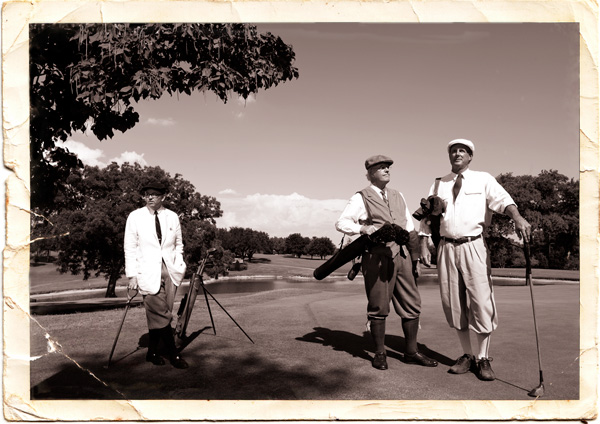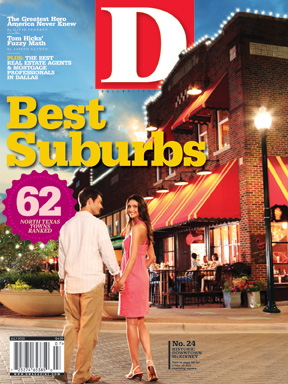With a cadre of how-are-you-sir employees within and a cool green oasis without, Brook Hollow Golf Club does not look like fertile ground for rebellion. And yet a handful of members of one of Dallas’ oldest old-money clubs are damn well fed up with the status quo.
When BHGC golfers John Crow Miller and Win Padgett dress for the game that consumes them, it’s pinpoint cotton dress shirts and conservative ties, long stockings, and plus fours or plus twos (the number referring to the terminal point of the pants in inches below the knee). Thence to the first tee they stroll, with clubs that rattle like broomsticks within skinny leather quivers. Their clubs have names, not numbers: spade mashie, niblick, jigger, brassie. The newest stick in Miller’s kit was built by hand in 1925, and, like all the rest of his weapons, it has a wooden shaft. Hickory.
The other members laugh or stare or wave, but once in a while someone joins the revolution. Rick Bauer grew up in Dallas, but farming 12,000 acres of West Texas cotton has kept him away for most of his adult life. The 1969 Highland Park High graduate moved back home in 2007 to enjoy a peace that passeth understanding, the peace of an unmarried, relatively young retiree in good health, his karma in balance from charitable work for Scottish Rite Hospital, with excellent golf skills and the wherewithal to belong to beautiful Brook Hollow. But Bauer is a troubled man, too. He discovered that the game he’s been playing since age 9 has disappeared.
“Great golfers used to be artists, and golf clubs were works of art,” he says with a sigh over Budweisers and burgers at Lee Harvey’s. “Now the equipment is so high-tech and the game is so commercial. I’m tired of it. I reached my limit. I wasn’t enjoying it.”
Antique golf devotees Miller and Padgett know the feeling: the ubiquity of Nike swooshes and of Nike’s spokesmodel, Tiger Woods; and the dumbing down of the game itself by the technical perfection of modern equipment. So Miller and Padgett embrace golf’s tweedy past by playing with clubs older than your grandma. Like people into roots rock or bow ties, they don’t much care what you think about their odd hobby, and though they love a convert, they want only those who are pure of heart. So before marching Bauer forward into the past, the acolyte would have to pass two tests. First, would he be willing to invest his time and money to acquire some good but—naturally—very used hickory-shafted golf sticks? He would; in February, Bauer attended the annual Dayton Golfing Trade Fair in Dayton, Ohio. Test two: he’d have to like it. Back at Brook Hollow, armed now with the equivalent of five or six World War I-era Springfield rifles, Bauer did like it. This new-old version of golf made a hard game harder, and he was at least 50 yards shorter off the tee. But wood sticks made the game feel more humble and elemental. Sometimes—especially when he has a double Glenfiddich halfway through his round—Bauer senses the ancients who whacked leather and feather balls centuries ago.
Picture Miller and Padgett silently nodding to each other. Yes, this one is worthy to join Hogwarts. Miller told Bauer of the big biennial wizards’ convention—that is, a golf tournament called the Hickory Grail—to take place in Sweden at the end of July. United States versus Europe, just like the Ryder Cup. As an organizer of the event in 2000, Miller was authorized to add Bauer to the roster. Would he like to take this final step?
Sweden? A tournament? To take this fantasy seriously? “Jeez, I don’t know,” Bauer said.
===Both teams walked from the front of Falsterbo Golfklubb to its rear patio for the opening ceremony. Flags flapped and photographers snapped the beknickered golfers against a stunning background of sand dunes, golf course, and the cool blue Baltic Sea.!==
Navy blazers; blazer patches; tan plus fours; long-sleeved white dress shirts; subdued ties and stockings; black shoes; Roaring Twenties-style flat caps; no logos on anything—Team USA was ready to march. The 16-member squad included me, a replacement for Padgett, who was ill; Miller, the majordomo; Bill Farmer, a very strong player also from Brook Hollow; and a somewhat dazed and confused Rick Bauer, battling vertigo caused by allergies and the unreality of representing the United States in anything.
Both teams walked from the front of Falsterbo Golfklubb to its rear patio for the opening ceremony. Flags flapped and photographers snapped the beknickered golfers against a stunning background of sand dunes, golf course, and the cool blue Baltic Sea. Someone dropped the needle on a recording of the Star-Spangled Banner and, despite its polka-like presentation, Bauer felt himself blinking back tears.
Polyglot Europe followed with an infinitely more stirring anthem: Ode to Joy—words by Friedrich Schiller, music by Ludwig van Beethoven. We eyed their much larger team while the music played. Among their collection of Swedes, Scots, Finns, and English was one German, a pleasant fellow from Hamburg named Christoph Meister, who seemed to be mouthing the words to the Ode in the original language. “Freude, schöner Götterfunken …”
And—Götterfunken!—look who else besides the Hamburger is on their team. That’s Fulke, isn’t it? Pierre Fulke of Eksjö, Sweden, has won three tournaments on the European PGA Tour, and he made the 2002 Ryder Cup team. In that biggest of all golf events, Fulke and his partner lost a match to Phil Mickelson and David Toms, but Fulke, an impressive, impassive chap with a full head of dark gelled hair, held Davis Love III to a tie in the singles. Europe won. Standing near Fulke was Adam Mednick of Lund, Sweden, also a winner on the Euro Tour, and Fulke’s partner in a golf course architecture business. Plainly the Continentals did not intend to lose. But as good as Fulke and Mednick were, they were not the strength of their team.
Lunch. The buffet cost 95 Swedish Krona—about $13—and featured herring pickled in various interesting viscous liquids, and Swedish meatballs, which are tiny and delicious. Several competitors—including Bauer—washed down the surf and turf and prematch jitters with a mug or two of Pripps Bla or other Swedish beer. The games began.
Miller and I drew Mika Hjorth and Antti Paatola, terrific guys who I mentally referred to as Finn One and Finn Two. Hjorth, 35, an importer of sporting goods, hit the ball so hard it was as if he didn’t like it. He seemed capable of beating us without help from Paatola, a slightly older man so enamored of hickory golf that between collecting and selling and running tournaments, he really does nothing else. But due to the vagaries of the handicapping system, we had to give our friendly rivals 17 shots. Which is to say: on every hole but one, for Miller and me to win a hole, we would have to score two shots lower than our new friends from Vantaa and Klaukkala. That wasn’t going to happen. I tried everything, including my Norway joke: “How can you tell an outgoing Norwegian? He looks at your shoes when he talks.” But nothing worked, except for the condolence beer Hjorth handed me afterward.
And so it went. The next morning, Bauer and I played John Sherwood of Canterbury, England, and the inimitable Willie Tanner of Dunfermline, Scotland. Actually, Tanner was imitable, at least up to a point. An actor in community theater, the home state of his opponents reminded the barrel-chested man of when he’d been in the cast of Best Little Whorehouse in Texas. “Looks like you Texas boys done stepped in some Aggie s—,” he said, a line from the play delivered in an intriguing blend of Scottish brogue and molars-together John Wayne. “Done stay-upped in some Aggie she-it,” repeated Bauer, laughing so hard throughout the round that he had to look for trees or shoulders for support. Tanner and Sherwood also got 17 shots, and they had the putting touch of safecrackers, and they killed us. Then came the singles. Bauer, Miller, Farmer, and I lost those, too. It was over. “Mare earl tock,” we said in the boozy aftermath, “More beer, please” being the only Swedish phrase some of us learned. Photographers shot Fulke posing with the silver trophy; he is the only man to have won both the Ryder Cup and the Hickory Grail.
At the dinner that night celebrating Europe’s lopsided victory, Miller, Breck Speed (Little Rock), and Ron Beatt (Newport-on-Tyme, Scotland) performed golf-themed parodies of two Abba songs, “Fernando” and “Waterloo.” I sidled up to Fulke’s table to ask him how many years he’s been playing hickories. “Today was my fifth round ever,” he said with a little smile. His business partner, Mednick, convinced him to try the old-timey game, and Pierre almost made a hole in one with the first swing he took. “I see this as a growth sport,” he said. “It brings back the thinking and the challenge of every shot.”
A few minutes later, someone reminded American team captain Roger Hill (Grand Rapids, Michigan) that between salads and entrées he would be required to make a toast. “What should I say?” he asked. I quickly scrawled a suggestion on the back of a program: “We Americans have long been impressed by the cars and cellphones you build, and by your art, culture, and history. And now we discover another magnificent European creation: your handicaps.” Captain Hill instead held up a glass of red and said something about brotherhood achieved through the shared challenges of hickory golf.
===
Nearly everybody on the grounds wore throwback outfits. God help me, I found the long skirts and pinned-up hair the women wore to be strangely exciting. A Civil War re-enactment atmosphere prevailed, a feeling that we were all in on the same private joke.
!==
Before we foreigners took the bus to the station in Malmö and the train to the airport in Copenhagen, our weird drama had a final act: the Svenska Hickorymästerskapet, the Swedish Hickory Championship.
For a week, our clothes and clubs had been gawked at and giggled over by Swedish kids with lank blond hair and hip-hugger pants. But not on this day. Nearly everybody on the grounds of Falsterbo Golfklubb—the 182 participants and many of the several hundred in the gallery—wore throwback outfits. God help me, I found the long skirts and pinned-up hair the women wore to be strangely exciting. A Civil War re-enactment atmosphere prevailed, a feeling that we were all in on the same private joke. And there were so many of us; few tournaments attempt to start more than 140 or so players, but the very long summer days at this latitude allowed for starting times from 6:30 am to 3 in the afternoon.
Fulke did not win. He tied for first at 74 with another Swedish pro named Per Nyman, who birdied the first hole in a playoff to take the prize. Nor did Bauer go out in a blaze of glory. His Walter Hagen Iron Man sand club broke, just snapped almost in half at the hosel from 90 years of metal fatigue. Mourning the loss of his best and, at $250, the most expensive of his clubs, and fighting a desire to use his poorly balanced putter to start a fire on the beach—and then to lie down next to it—Bauer shot 93. It was his first round north of 90 since he was 11 years old.
But for Miller, club heads that break and shafts with a little bend in them are part of the charm. Those who play reproduction hickories are missing the point. “The quirkiness of a handmade club is lost,” he says. “Old clubs hold their value—and they’re not that hard to find, despite what some people say. But reproductions are like Chevy Tahoes once you drive them off the lot. If you really get into the spirit of the thing, you’ll put those reproductions aside.”
The spirit of the thing—what was it, really? Sometimes it felt like having to change a flat tire on the way to church: though dressy in our plus fours and ties, we had to sweat to do the merest thing, such as getting the ball airborne. But the lack of logos on shirts and hats and bags did a lot to lift the mood, as did the modesty and human scale of the game itself.
Bauer got hooked like a big fish. He plans to return to Sweden next year for the Hickorymästerskapet. He’s got a new sand wedge. It’s only 80 years old.






